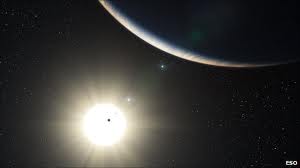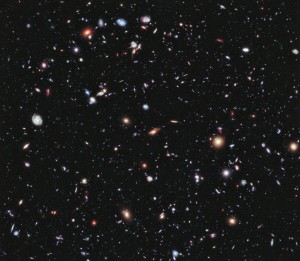
We know they’re out there, and now we’re closer than ever to finding gravity waves. (Picture Credit: NASA).
You may have noticed recent media articles announcing further confirmation of gravitational waves via indirect observation. Scientists have discovered that a white dwarf binary system (J0651) is losing energy at the rate predicted by Einstein when he proposed the existence of gravitational waves. This is very exciting news in the field of gravitational radiation, as it’s the second indirect confirmation of Einstein’s theory of relativity in relation to gravitational waves.
So – what are gravitational waves? Einstein first proposed that gravity is the result of massive objects curving space, and that when some of those large objects collide, explode, or accelerate, they would create waves of energy. This energy, known as gravitational radiation, travels through space at the speed of light in small waves. Einstein suggested that gravitational waves could be produced by the interactions of two or more massive objects, which could be binary star systems, or black holes, or even neutron star binary systems.
When these objects violently interact, the resulting energy propagates through space, in waves, at the speed of light, only very weakly interacting with matter. Even thought gravitational waves are produced by large-scale violent interactions, they diminish as they travel through space, but never die.
That’s all good for the theory but what have observations shown? Unfortunately despite a lot of work there is no direct evidence (ie we haven’t actually observed a ‘wave’) to prove the existence of gravitational waves. However the good news is that astronomers have indirect evidence that Einstein was right!
Einstein’s theory says that gravitational waves, produced by interacting objects (say two neutron stars), essentially rob orbital energy from the stars and as a result the star’s rotation will slow down.
In 1974 Russell Hulse and Joseph Taylor Jr. discovered PSR B19+16, a pulsar in orbit with a neutron star. Their measurements showed that the objects were slowing down at a rate consistent with Einstein’s predictions. Further measurements confirmed the two objects will slow down enough to eventually spiral into each other in about 300,000,00 years. For confirming the (theoretical) existence of gravitational waves, Hulse & Taylor received the 1993 Nobel Prize in Physics!
Aerial view of the The Laser Interferometer Gravitational-wave Observatory in Hanford, WA, USA. (Credit: LIGO Laboratory)
So we know that a disturbance between two massive objects, such as two black holes or a neutron star and pulsar will produce gravitational waves; the more mass involved in the interaction, the stronger the wave. So how much energy are we talking about? Some have suggested that such an interaction could release the energy of many trillions of nuclear explosions, much of which would radiate away in the form of gravitational waves. That sounds like a lot of energy, but as gravitational waves travel through space, the energy in the wave decreases inversely with the square of the distance from the source. By the time the wave reaches Earth, it’s barely detectable.
Gravitational waves can travel through regions of space, which are impenetrable to electromagnetic waves, and they pass through matter without scattering. If we can eventually build a detector sensitive enough, we may be able to gather data on distant and exotic objects that can’t be gathered by other means.
Since the 1960’s an enormous amount of effort has gone into creating sensors sensitive enough to detect gravitational waves. There are two ways to directly observe gravitational radiation:
* Measuring the amount of strain on an object caused by a passing gravitational wave, and
* Measuring the variation in separation of suspended masses caused by a passing gravitational wave.
There are many gravitational detectors in operation, run by various organizations, across countries, using different technologies. There are also a number of detectors still in the planning or construction phase. Interferometers, just one type of detector, are very popular due to their high angular resolution. Interferometers are detectors that are able to cover wavelengths between a few Hz up to a few kHz, and are designed to achieve high angular resolution by connecting two or more telescope elements, such as mirrors, or antennas to operate as a single entity.
Interferometers are set up so that when gravitational waves pass through the detectors, lasers record and measure the difference in variation as a result of the wave stretching space-time, between the arms. The greater the distance between masses – the more sensitive the detector is to small variations. This is why interferometers are built with extremely long ‘arms’, to increase the sensitivity of the detector. Of course on the ground interferometers are limited by practical implications of building costs, land acquisition, geography and terrain. The effectiveness of gravitational wave interferometers is also limited by the noise sources, including thermal noise of suspended test masses, photon shot noise and seismic noise.
Interferometer detectors include the promising LIGO and VIRGO detectors.
The LIGO detector operates in two sites in the United States, Louisiana and Washington. Each site has three multi-kilometer interferometers. The sites are just over 3000km apart and are sensitive to gravitational wave strains smaller than one part in 10–25. The LIGO is being upgraded and is due to be operational in 2014.
The VIRGO detector in Italy commenced operation in 2007. VIRGO has two three-kilometer orthogonal arms, and is configured so that many reflections between mirrors at the end of each arm extend the effective optical length of each arm up to 120 about kilometers. VIRGO’s frequency range (from 10 HZ to 10 kHZ) should allow detection of gravitational waves produced by supernovae, the coalescence of binary systems in our own and other galaxies.
LISA, the Laser Interferometer Space Antenna, is a spacecraft designed to detect and measure gravitational waves. LISA’s design consists of three spacecraft that form three corners of a large triangle, which will orbit the sun, behind Earth. Lasers will very precisely measure the distance between the spacecraft, and if there is a slight change in the distance between the spacecraft, detect the passage of gravitational waves.
LISA was planned for launch in around 2018, unfortunately NASA has canceled the project, as it could not financially commit to the costly and ambitious project. However there is a possibility that the project may be re-configured and resurrected by the ESA.
Pulsar timing arrays are another way of detecting gravitational waves. Pulsar timing arrays examine signals from well-known millisecond pulsars, and attempt to detect any potential effect on the signals. As mentioned earlier, gravity waves are polarized, so as a gravitational wave passes through the earth, it will stretch and contract space. As a result the timing of signals from the pulsar are shifted accordingly – and will hopefully be picked up by a pulsar timing array detector. The ‘Dish’ at Parkes, NSW, Australia has been involved in pulsar timing observations.
Despite the rapid and comprehensive improvement in detector technology, no gravitational waves have been found. The discovery of PSR B19+16, and now J0651, gives encouragement that with the implementation of more powerful and sensitive detectors, we are prepared to detect any gravitational waves.
Any successful detection of gravitational waves will provide a new and different view of astrophysical processes hidden from other forms of astronomy. So far the dynamics of exotic objects including supernova, neutron stars, black hole mergers have remained elusive. The final detection of gravitational waves will give us a better understanding of these types of objects, and this technology may lead us to uncover information about the early universe including the Big Bang and rapid expansion of the universe.
Sharon
I originally wrote this article for Astro Space News. You can find the article in the features section at www.davereneke.com





